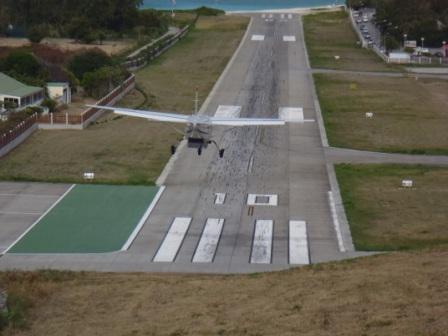St Barts ""17:54.30N 62:51.60W"

VulcanSpirit
Richard & Alison Brunstrom
Fri 15 Apr 2011 00:50
|
Another curiosity. St Barthelemy was named in
1493 by Columbus after his elder brother. It had no water source and so was
not settled by Europeans until the French arrived in 1648. The first colonists
were massacred by the Caribs but a settlement eventually prospered based on
piracy aginst the Spanish, and the evaporation of sea salt. In 1784 the French
king gave the island to Sweden in exchange for trading rights in Gothenburg (the
Swedes wanted it for the salt pans), and it remained in Swedish hands until 1878
when it was sold back to France in a constitutional process
called 'retrocession' - a word I have never come across before and will probably
never have occasion to use again. Definitely one for the pub quiz
tie-breaker.
Anyway, it's a delight. Tiny, hilly, dry and now
rich. There are 7500 locals who all speak English and French. It has gone
from forgotten backwater to premier holiday spot in a generation and is yet more
evidence of how much better the French have been at handling their Caribbean
islands since WW2 than have been the British. The capital Gustavia looks as if
it were in the Med not the Caribbean and the shopping is just amazing (if you're
rich). The population is very largely white (there were no slaves because the
land was too dry for agriculture) and the economy is based almost entirely on
tourism. But no cruise ships, and no big planes (see below), so it's very
select.
Here is the waterfront, with cheapskate tourist
sneaked in by sea:
  There are lovely beaches (of course)
but you've probably seen enough of them already. And fabulous villas
but they're private, and seventy restaurants but they're unphotogenic, so here
is a shot of me on a scooter instead
(hired at 40 euros per day - a car on St Maarten is
US$30!):
 The scooter seats two and is OK once you get used
to it. The trick going up the (very) steep hills is to accelerate hard and lean
forward which works fine until you come to a hairpin bend. But we survived.
The airport runway is so short that the biggest
plane able to land is a seven seater. To take the photo below, looking
down on a landing plane which has just flown over my head, I was
standing on a ridge top road. Immediately after crossing the road the pilot
has to drop about 200m more or less straight down in order to get onto the
runway in time to stop before he falls off the end into the sea. Not for the
fainthearted!
 Anyway, we met our guy (he actually jumped into our
dinghy from a yacht sailing past - very James Bond), got the sail up,
tested, and approved. He's flown back to Antigua, and we've gone back to St
Maarten to get, amongst other things, those iguana shots. And go to the pictures
for the first time since we saw 'The Good, The Bad & The Ugly' at the film
club in the Arts Cafe in Tobermory on the Isle of Mull last July.
|